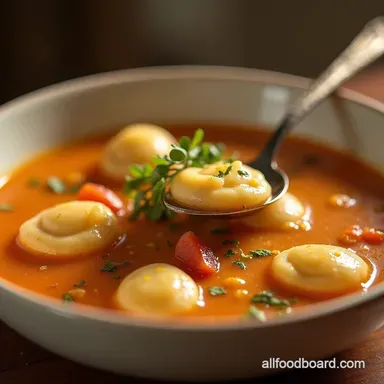The Nonnas Secret Italian Penicillin Soup with Tiny Dumplings Minestra di Guarigione

Nonnas Penicillin Soup

Ingredients:
Instructions:
Nutrition Facts
The Ultimate Bedside Elixir: Understanding Italian Penicillin Soup
When the world feels fuzzy and your throat feels scratchy, there’s a universal truth whispered across generations: soup heals. While American kitchens often turn to standard chicken noodle when illness strikes, the Italian approach offers something deeply sophisticated yet wonderfully simple: Italian Penicillin Soup . This restorative dish, known in Italy as Minestra di Guarigione (Healing Soup), is far more than just heated liquid; it’s a carefully constructed blend of savory depth and bright acidity designed to soothe the soul and nourish the body when you need Comfort Sick Food most. Forget manufactured remedies; this is the original culinary cure, built from scratch to deliver maximum comfort and flavour.
Defining 'Minestra di Guarigione': A Culinary Tradition
The magic behind this soup lies in its intentional clarity and purity of flavour. Unlike heartier winter stews, this preparation focuses on extracting maximum flavour from bones and aromatics into a pristine broth. The Italian Penicillin Soup Ingredients are chosen not just for taste, but for ease of digestion. It’s typically light enough to settle even the most sensitive stomach, making it ideal Easy Food When Sick . The central components usually include a robust homemade stock, very small pasta or dumplings, and the critical addition of lemon juice at the end to cut through congestion.
The Secret Weapon: Flavor Infusion Over Complexity
The reason this soup earns its reputation as the Best Sick Soup lies in the slow, gentle infusion process. We are not looking for chunky vegetables or heavy starches. Instead, we coax the deep, earthy notes from carrots, celery, and onion, mingling them with the rich essence of roasted chicken bones. This method yields a crystal-clear broth—the foundation of our remedy. This clarity is key; it ensures that even when appetite is low, the flavour is profound enough to be satisfying, positioning it perfectly as one of the Good Foods To Eat When Sick .
Is This Soup Truly Gluten-Friendly? A Note on Pastina
A defining characteristic of this specific iteration of Italian Penicillin Soup with Chicken is the inclusion of tiny pasta shapes or semolina dumplings, often referred to as pastina or gnocchetti . While traditional versions use wheat-based semolina or flour, which naturally contains gluten, understanding the substitution options is crucial for modern dietary needs. The goal of the starch component is simple: provide just enough substance to make the meal feel complete without weighing down the digestive system.
Assembling Your Healing Arsenal: Essential Components
Preparing this soup is a two-part adventure: first, creating the flavour powerhouse of the broth, and second, mixing the delicate dumplings that absorb all that wonderful liquid. For the base, you’ll need about 2 lbs of chicken or turkey carcass/bones (or 4 large bone-in thighs) to yield approximately 10 cups of water, which should reduce down to 8 cups of concentrated stock after simmering. Don't forget the basic building blocks: two medium carrots, two celery stalks, one quartered yellow onion, four smashed garlic cloves, two bay leaves, a small bunch of parsley stems tied together, and one teaspoon of black peppercorns.
Selecting the Perfect Foundation: Broth and Aromatics
To elevate the broth from merely "chicken stock" to the healing elixir required for this Italian Penicillin Soup Recipe , we suggest briefly roasting the bones first. A short stint in a 400° F oven for about 20 minutes deepens the colour and concentrates the meaty flavour profile significantly. When combining the aromatics with the bones and the 10 cups of cold water, bring the mixture slowly to a simmer. This gentle heating prevents cloudiness, ensuring the final result is beautifully transparent.
Tiny Dumplings Dilemma: Choosing the Right Pastina Shape
For the dumplings, known in this context as gnocchetti or very small maltagliati , we are opting for a simple semolina dough. You will combine 1 cup of fine semolina flour with one lightly beaten large egg, a pinch of salt, and about 2 tablespoons of water or reserved broth. The dough should be lightly kneaded, rested for 15 minutes to hydrate, and then rolled paper-thin before being cut into diminutive squares—no bigger than your pinky fingernail. This size ensures they cook quickly and remain tender.
Freshness First: Essential Herbs for Maximum Potency
While the parsley stems go into the broth for depth during the simmer, the flavour brighteners must be fresh and added at the very last moment. You will need about a quarter cup of fresh parsley, finely chopped, and the zest and juice of one bright, fresh lemon. The lemon is non-negotiable; its sharp acidity is what elevates this broth from comforting to truly restorative.
Equipment Checklist: Tools for a Congested Cook
Since you might not have the energy for complex techniques, keeping the equipment simple is vital. You primarily need a large stockpot (6-quart minimum), a mixing bowl for the dough, and most importantly, a fine-mesh sieve or piece of cheesecloth for straining the final broth. Having these ready prevents unnecessary searching when you’re feeling sluggish.
Related Recipes Worth Trying
- Rich Creamy Keto Taco Soup Recipe Fiesta in a Bowl — This Easy Keto Taco Soup recipe uses ground beef and cream cheese for incredible flavour Its a hearty low carb dinner ready in under an hour
- The LowCarb Fiesta Bowl Hearty Keto Taco Soup Recipe — Ditch the beans and carb confusion This Keto Taco Soup recipe is rich zesty and uses cream cheese for perfect low carb dinner comfort Get the easy steps now
- Ultimate Old Fashioned Vegetable Beef Soup Recipe — Forget weak broth This easy homemade vegetable beef soup recipe uses chuck roast for incredible depth Perfect for a chilly day Get the full steps here
Crafting the Flavor Base: Simmering the Vegetal Core

The process begins with Step 1: combining your roasted bones, the roughly chopped carrots, celery, onion, smashed garlic, bay leaves, parsley stems, and peppercorns in the large stockpot, covering everything with the 10 cups of cold water. Heat this mixture slowly over medium heat until it just begins to bubble lazily at the edges. Once that first wisp of steam appears, reduce the heat immediately to the lowest setting—a gentle simmer is the goal. For the first half-hour, watch carefully and skim any grey foam that rises to the surface; this ensures a clean final product. Allow this mixture to simmer, partially covered, for at least one hour; 90 minutes is even better for a truly deep flavour, creating the perfect base for your Easy Soup Dinner .
The Final Assembly: Incorporating the Pasta and Brightening Notes
Once your broth has simmered its magic and achieved the necessary depth, it must be clarified. Strain the entire contents through a fine-mesh sieve into a clean pot, discarding all the solids. Taste this magnificent liquid—it is now time to season with salt to your preference. Return this refined broth to a gentle simmer and prepare for the final additions.
Step-by-Step: Building the Aromatic Vegetable Mirepoix
(Note: Since the aromatics were used to build the stock base, they have already been incorporated and strained out, providing their flavour essence without leaving behind fibrous bits that impede digestion, a critical step in creating this light soup.)
Achieving Crystal Clarity: Managing the Broth Stage
The straining process is non-negotiable for achieving the expected clarity of a genuine Minestra di Guarigione . If you find your broth is slightly murky after the initial straining, line your sieve with cheesecloth for a second pass. This effort yields a broth so clear you can read a newspaper through it—the sign of a perfectly extracted stock ready to embrace the dumplings.
When to Introduce the Pastina: Avoiding Mushy Results
With the strained broth simmering gently, it’s time to introduce the tiny semolina dumplings you prepared earlier. Drop them in carefully, ensuring they don't stick together. They cook incredibly fast. Once they rise to the surface—usually within 3 to 5 minutes depending on their thickness—they are almost done. Give them an extra minute or two to ensure they are cooked through but retain a pleasant, slight chewiness, preventing the dreaded mushy texture that ruins Comfort Sick Food .
The Essential Lemon Finish: Brightening the Italian Penicillin Soup
This is the moment that transforms the dish into bona fide Italian Penicillin Soup . Turn the heat completely OFF. Stir in the finely chopped fresh parsley and the grated lemon zest. Finally, pour in the fresh lemon juice. Do not return the soup to a boil after adding the lemon juice; excessive heat turns citrus flavour bitter and diminishes its Vitamin C benefits. This final, bright addition is what makes every spoonful feel like a restorative burst.
Maximizing Recovery: Storage and Reheating Tips
Even when you are feeling better, this soup is so good you will want leftovers. Luckily, it stores wonderfully, providing a quick, nourishing meal for days to come.
Freezer Fidelity: How Long This Soup Stays Miraculous
The broth and dumplings freeze exceptionally well, making it a fantastic meal prep option for cold season. Once cooled completely, transfer the soup into airtight containers, leaving about an inch of headspace. It will maintain its supreme quality in the freezer for up to three months. When reheating, thaw overnight in the refrigerator and gently warm on the stovetop; avoid aggressive boiling to protect the delicate dumpling texture.
Protein Boost: Adding Chicken or Legumes to the Base
If you’re feeling slightly stronger and require more substance, this soup welcomes additions. You can shred any leftover cooked meat from the bones used to make the stock (if you used bone-in pieces) and add it back in during the last 10 minutes of simmering the dumplings. Alternatively, a can of rinsed cannellini beans added alongside the dumplings provides a lovely, gentle plant-based protein lift.
Gluten-Free Grains Swap: Alternatives to Traditional Rice or Pasta
For those avoiding gluten, excellent substitutions exist for the semolina dumplings. You can substitute the dumplings entirely with very small pastina shapes like Acini di Pepe or orzo, ensuring you cook them separately first or monitor them very closely in the broth to prevent them from absorbing too much liquid. Another excellent alternative is using tiny grains like white quinoa or small pearl couscous (if consuming gluten), cooking them according to package directions before adding them to the finished broth.
The 'More Pep' Factor: Spice Variations for Adults
While the traditional recipe focuses on gentle warmth, adults recovering often crave a little extra heat. To customize this Italian Penicillin Soup Recipe for adults, incorporate a pinch of Calabrian chili paste or a few drops of your favourite hot sauce into the broth while it simmers. A small pinch of dried oregano added along with the bay leaves can also impart a more rustic, herbaceous background note.
Serve this bowl steaming hot, perhaps with a final grating of salty Parmigiano-Reggiano cheese, and allow the tradition, warmth, and brightness of this perfect Comfort Sick Food to guide you back to full strength.

Recipe FAQs
Can I make the Italian Penicillin Soup ahead of time, and how should I store leftovers?
Absolutely, this soup keeps brilliantly, much like a proper roast dinner! You can store the broth and dumplings separately in the fridge for up to three days, or freeze the broth for up to three months. When reheating, be aware that the tiny dumplings might absorb extra liquid; just add a splash of water or extra broth to loosen it up before serving.
My broth turned out a bit cloudy, not clear like yours. What did I do wrong?
Don't fret, it happens to the best of us; even a seasoned cook can have an off day! Cloudiness usually comes from boiling the stock too vigorously, which emufies the fats and proteins, making it murky. For next time, keep it at a very gentle, lazy simmer and ensure you skim off any scum that rises in the first half-hour—that’s the secret to that lovely golden clarity.
What if I don't want to make the tiny dumplings? Can I substitute something else in the Italian Penicillin Soup?
Of course! If rolling out dough sounds like too much bother when you’re feeling poorly, you have a few easy swaps. You could use very small pastina (like acini di pepe or stelline pasta) or even small, broken-up pieces of dried angel hair pasta. Just remember to adjust the cooking time according to the package directions for your chosen substitute.
Is there a way to make this soup heartier if I'm serving it as a main meal rather than a sick-day cure?
If you need it to be more substantial than a gentle comfort food, you certainly can bulk it up. Try adding shredded cooked chicken breast back into the strained broth, or stir in a handful of finely chopped greens like kale or chard right at the end. Serving it with plenty of crusty bread for dipping also makes a big difference!
The recipe calls for fresh lemon juice right at the end. Why is timing the addition of lemon so crucial?
That fresh lemon brightens the whole bowl, acting as the final flourish, much like a perfect dusting of icing sugar on a dessert. If you add the juice while the soup is actively boiling, the heat breaks down the delicate compounds, leading to a flat or even slightly bitter taste. Take it off the heat, stir in the zest and juice, and let the residual warmth do the job.